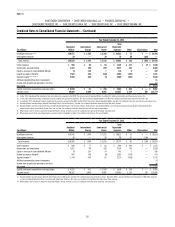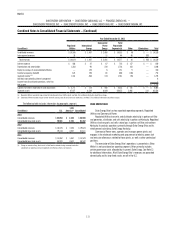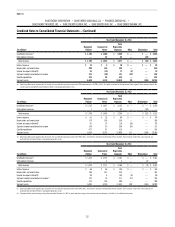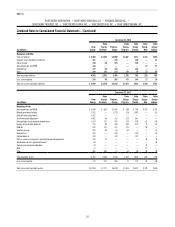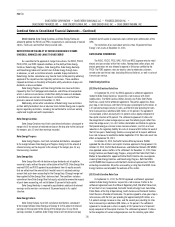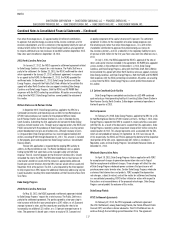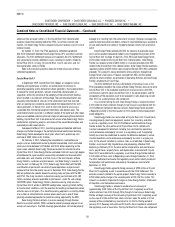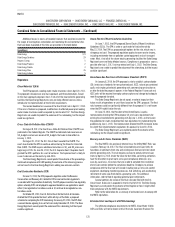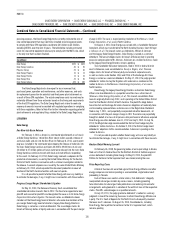Duke Energy 2013 Annual Report Download - page 134
Download and view the complete annual report
Please find page 134 of the 2013 Duke Energy annual report below. You can navigate through the pages in the report by either clicking on the pages listed below, or by using the keyword search tool below to find specific information within the annual report.
116
PART II
DUKE ENERGY CORPORATION • DUKE ENERGY CAROLINAS, LLC • PROGRESS ENERGY, INC. •
DUKE ENERGY PROGRESS, INC. • DUKE ENERGY FLORIDA, INC. • DUKE ENERGY OHIO, INC. • DUKE ENERGY INDIANA, INC.
Combined Notes to Consolidated Financial Statements – (Continued)
Storm reserve. Duke Energy Carolinas and Duke Energy Florida are
allowed to petition the PSCSC and FPSC, respectively, to seek recovery of named
storms. Funds are used to offset future incurred costs.
RESTRICTIONS ON THE ABILITY OF CERTAIN SUBSIDIARIES TO MAKE
DIVIDENDS, ADVANCES AND LOANS TO DUKE ENERGY
As a condition to the approval of merger transactions, the NCUC, PSCSC,
PUCO, KPSC, and IURC imposed conditions on the ability of Duke Energy
Carolinas, Duke Energy Progress, Duke Energy Ohio, Duke Energy Kentucky
and Duke Energy Indiana to transfer funds to Duke Energy through loans
or advances, as well as restricted amounts available to pay dividends to
Duke Energy. Certain subsidiaries may transfer funds to the parent by obtaining
approval of the respective state regulatory commissions. These conditions
imposed restrictions on the ability of the public utility subsidiaries to pay cash
dividends as discussed below.
Duke Energy Progress and Duke Energy Florida also have restrictions
imposed by their rst mortgage bond indentures and Articles of Incorporation
which, in certain circumstances, limited their ability to make cash dividends
or distributions on common stock. Amounts restricted as a result of these
provisions were not material at December 31, 2013.
Additionally, certain other subsidiaries of Duke Energy have restrictions
on their ability to dividend, loan or advance funds to Duke Energy due to specic
legal or regulatory restrictions, including, but not limited to, minimum working
capital and tangible net worth requirements.
Duke Energy Carolinas
Duke Energy Carolinas must limit cumulative distributions subsequent to
mergers to (i) the amount of retained earnings on the day prior to the closing of
the mergers, plus (ii) any future earnings recorded.
Duke Energy Progress
Duke Energy Progress must limit cumulative distributions subsequent
to the merger between Duke Energy and Progress Energy to (i) the amount of
retained earnings on the day prior to the closing of the merger, plus (ii) any
future earnings recorded.
Duke Energy Ohio
Duke Energy Ohio will not declare and pay dividends out of capital or
unearned surplus without the prior authorization of the PUCO. Duke Energy Ohio
received FERC and PUCO approval to pay dividends from its equity accounts
that are reective of the amount that it would have in its retained earnings
account had push-down accounting for the Cinergy Corp. (Cinergy) merger not
been applied to Duke Energy Ohio’s balance sheet. The conditions include a
commitment from Duke Energy Ohio that equity, adjusted to remove the impacts
of push-down accounting, will not fall below 30 percent of total capital.
Duke Energy Kentucky is required to pay dividends solely out of retained
earnings and to maintain a minimum of 35 percent equity in its capital
structure.
Duke Energy Indiana
Duke Energy Indiana must limit cumulative distributions subsequent
to the merger between Duke Energy and Cinergy to (i) the amount of retained
earnings on the day prior to the closing of the merger, plus (ii) any future
earnings recorded. In addition, Duke Energy Indiana will not declare and pay
dividends out of capital or unearned surplus without prior authorization of the
IURC.
The restrictions discussed above were less than 25 percent of Duke
Energy’s net assets at December 31, 2013.
RATE RELATED INFORMATION
The NCUC, PSCSC, FPSC, IURC, PUCO and KPSC approve rates for retail
electric and gas services within their states. Nonregulated sellers of gas and
electric generation are also allowed to operate in Ohio once certied by the
PUCO. The FERC approves rates for electric sales to wholesale customers
served under cost-based rates (excluding Ohio and Indiana), as well as sales of
transmission service.
Duke Energy Carolinas
2013 North Carolina Rate Case
On September 24, 2013, the NCUC approved a settlement agreement
related to Duke Energy Carolinas’ request for a rate increase with minor
modications. The North Carolina Utilities Commission Public Staff (Public
Staff) was a party to the settlement agreement. The parties agreed to a three-
year step-in rate increase, with the rst two years providing for $204 million, or
a 4.5 percent average increase in rates, and the third year providing for rates
to be increased by an additional $30 million, or 0.6 percent. The agreement
is based upon a return on equity of 10.2 percent and an equity component of
the capital structure of 53 percent. The settlement agreement (i) allows for
the recognition of nuclear outage expenses over the refueling cycle rather than
when the outage occurs, (ii) a $10 million shareholder contribution to agencies
that provide energy assistance to low-income customers, and (iii) an annual
reduction in the regulatory liability for costs of removal of $30 million for each of
the rst two years. Duke Energy Carolinas also agreed not to request additional
base rate increases to be effective before September 2015. New rates went into
effect on September 25, 2013.
On October 23, 2013, the North Carolina Attorney General (NCAG)
appealed the rate of return and capital structure approved in the agreement. On
October 24, 2013, the NC Waste Awareness and Reduction Network (NC WARN)
also appealed various matters in the settlement. On December 11, 2013, Duke
Energy Carolinas and Duke Energy Progress, along with the Public Staff, led a
Motion to Consolidate this appeal with other North Carolina rate case appeals
involving Duke Energy Carolinas and Duke Energy Progress. Both the NCAG
and NC WARN led responses with the North Carolina Supreme Court (NCSC)
contesting consolidation. All parties are awaiting a ruling from the NCSC. Duke
Energy Carolinas cannot predict the outcome of this matter.
2013 South Carolina Rate Case
On September 11, 2013, the PSCSC approved a settlement agreement
related to Duke Energy Carolinas’ request for a rate increase. Parties to the
settlement agreement were the Ofce of Regulatory Staff, Wal-Mart Stores East,
LP and Sam’s East, Incorporated, the South Carolina Energy Users Committee,
Public Works of the City of Spartanburg, South Carolina and the South Carolina
Small Business Chamber of Commerce. The parties agreed to a two-year step-in
rate increase, with the rst year providing for approximately $80 million, or a
5.5 percent average increase in rates, and the second year providing for rates
to be increased by an additional $38 million, or 2.6 percent. The settlement
agreement is based upon a return on equity of 10.2 percent and a 53 percent
equity component of the capital structure. The settlement agreement (i) allows
for the recognition of nuclear outage expenses over the refueling cycle rather






